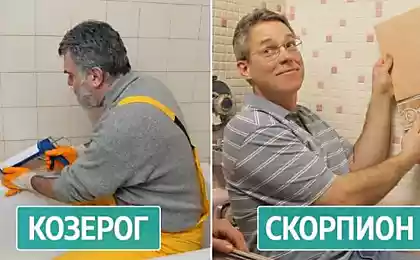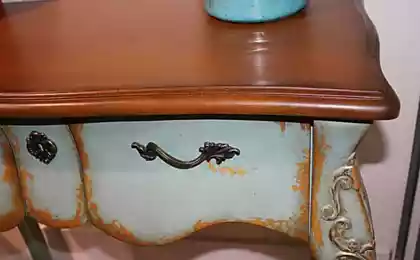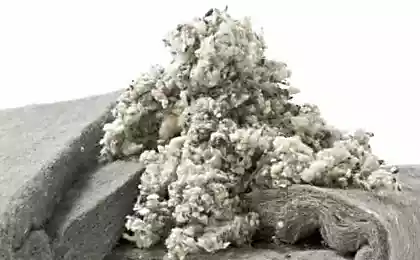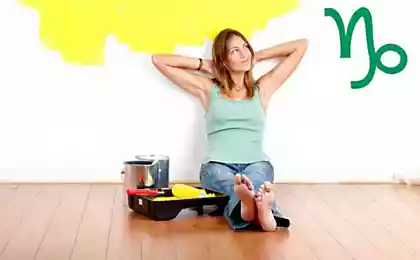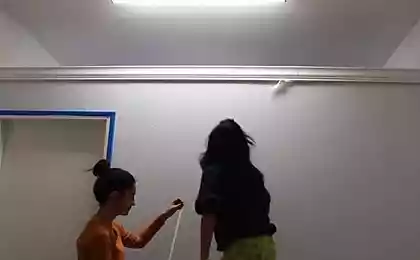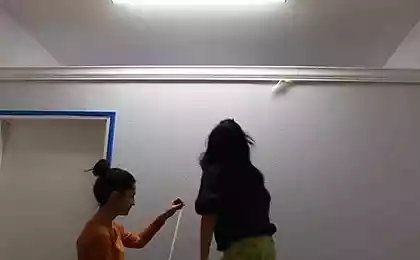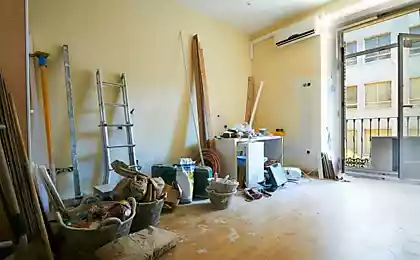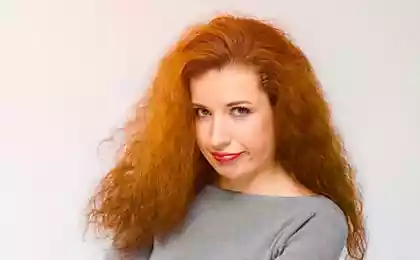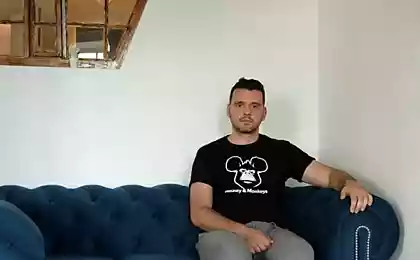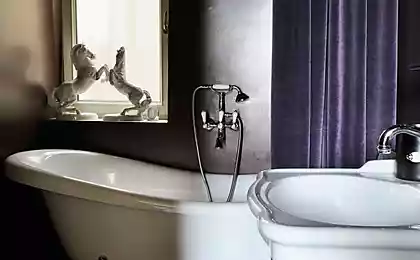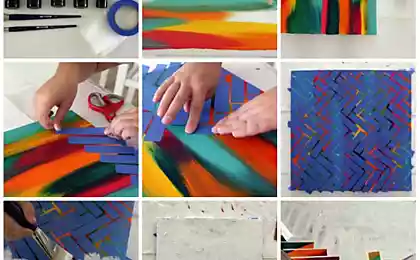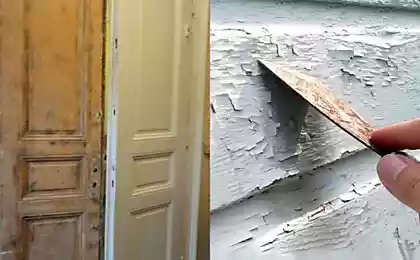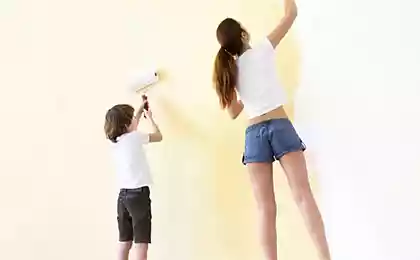876
All about the choice of wall paints: water-dispersion
If you started a repair, you will definitely have to devote time to the selection of materials for finishing. Let's meet them one by one. Let's start with the wall coverings and will discuss in this article the water-dispersion paints. What is it and is it worth to choose this type for finishing.
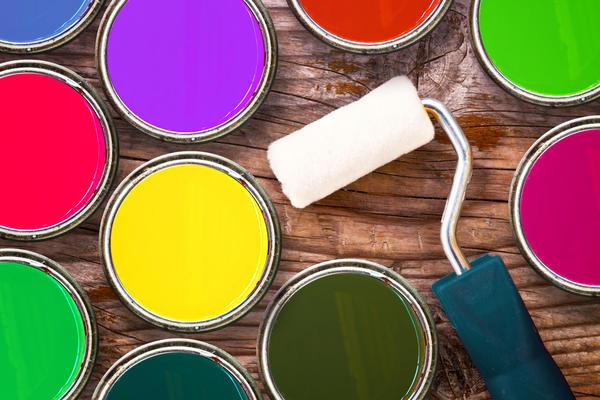
A bit of history paintsProbably none of us have ever thought about the question: how old are the inks? Meanwhile, archaeologists claim that people are already 17 thousand years, just imagine! Yes, of course, before the paint was a slightly different composition, but it has evolved along with humanity. The very nature of paints for centuries has not changed, was added different binding elements, and methods change the color. Because people saw the world in color and that I wanted to paint it. To obtain the pigments used and the minerals, and herbs — all that gives earth, including herself.
And later invented chemical compositions and obtained the desired shade. In the middle ages the pigments included even dangerous lead and arsenic... people's Lives these colors, of course, shortened, but perhaps thanks to them that we still admire paintings and frescoes of those times. In our 21st century paint tested for environmental friendliness, toxicity, safety... and in the diversity of colors and their application in our day you can write a thesis! However, we have another problem, why limit ourselves to a compact story.
The composition of water-dispersion paintsFirst, let's be clear about the scientific parameters of the composition of the aqueous paint. I will try to explain everything simple and clear. Water-dispersion paint is, in fact, water-filling. Filling, as a rule, represent a binder based on synthetic latexes and copolymers (acrylic or vinyl acetate). If to tell even easier is particles in the water which, after application to a surface (painting) and evaporation of the water, moving closer. Then these particles adhere to each other and form a film. Here and all science))
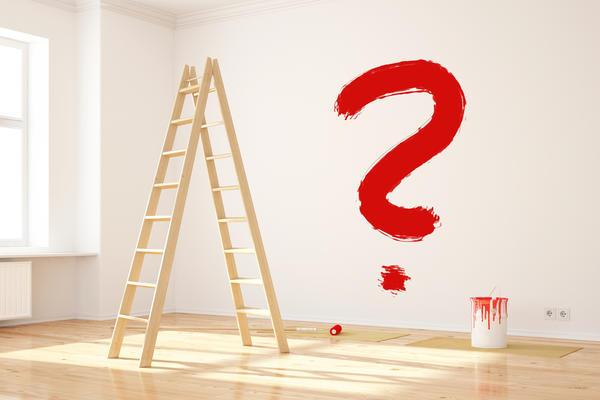
Water-dispersion paint contains no solvents. And even in our age, in it there are synthetic materials, it's still environmentally friendly, safe, easy to manufacture and use. In addition, water-based paint is odorless and "friendly" with almost any types of surfaces (excellent traction, adhesion). Therefore, it is widely used in construction industry for production facilities and in home repairs.
All water-based paints initially can be divided into two groups:
More attention I will give the acrylic paint, because, thanks to their qualities, they are more than others suitable for home use. This is a fairly common product that you will always find on the shelves of any hardware store. Acrylic paint is a water-dispersion acrylic paint binder (acrylates, or their copolymers). It is economical and easy to use, dries quickly, forms on the surface of the coating is vapor permeable ("breathes"). An important caveat: acrylic paints retain their color well and don't fade, withstanding intense UV radiation.
Since the surface treatment you have chosen painting, such a decision is hard to call wrong. Indeed, what could be the cons in this choice? On the contrary all the way)
The main disadvantage of painting is the surface preparation before its application. Ie: walls should be smooth plastered and desirable — perfect. To achieve this ideal, frankly, quite difficult, especially in older homes. You have to align the wall, edit the angles and stuff. However, to be honest, any other kind of decoration also can not hide the strong irregularities.
Now try to refute other cons that I most frequently heard from clients:
— I would have painted, but I have a new house — there is a shrinkage of the walls and plaster covered with cracks and it will be noticeable.
Indeed, when painting you need to consider some factors and this is one of them. However, this situation also there is a way — you can use fiberglass (fibreglass Wallpaper for painting). Only they are able to really reinforce a new surface, because sometimes the cracks are very macro! And any other Wallpaper can not necessarily macrofactors and tear. And selecting the glass cloth, you protect yourself from such troubles and you'll be able to repaint them to a few times. And, again, this option is not more expensive than other types of finishes — stone, tile or panels.
I don't like the smooth surface, I love texture.
These arguments against painting, too, put forward often enough. However, and here the producers have long provided for all of your "want" and "would be nice", and if a responsible approach to the selection and product search, you will find a lot of options!
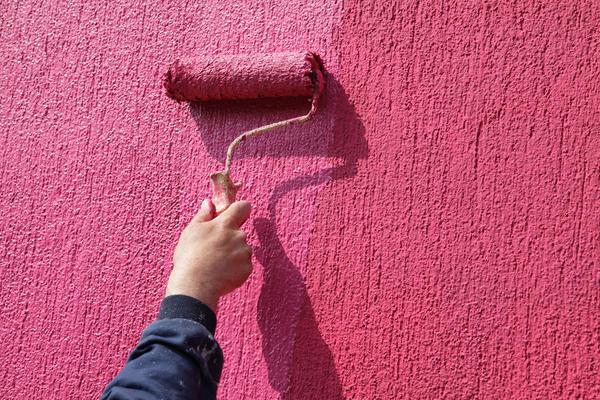
The importance of quality paintlet us start with a quality paint, which you can feel free to ask sellers. The paint should be:
More often, consumers are concerned about consumption of paint, and he believes that this indicator is important. However, in practice I have not noticed a significant difference in the data from different manufacturers. It is worth considering that, depending on the type of base paint consumption either decreases or on the contrary, increases. If the wall is prepared and primed, or updated a previously painted surface, the paint consumption will be minimal. And here is the Wallpaper for painting (especially fiberglass) "eat" the paint a lot more and the flow will be maximum. The manufacturer usually gives the average paint consumption: 1 litre to 6-8 sq metres. Given your size and the type of surface is not difficult to calculate the approximate volume of necessary products.
In the beginning of the article I said that the paint is durable. This property depends on the fastness to stress. Any manufacturer usually interior paint is available in 3 types:
For walls and ceilings is unstable covering for areas with a low level of traffic, suffers only dry cleaning, whitewashing allows the chalk, if it is rubbed with a hand, is unstable to mechanical stress. Moisture-proof coatings for space with a small level of traffic, tolerate wet cleaning (wiping and no more), is unstable to mechanical stress. Washable is a resistant coating for areas with heavy traffic of people, tolerate wet cleaning, soak a wash with a detergent composition, several cycles of washing with a brush. Note that this gradation is not common, so the paint name may be different, but in General, it is still presented in these 3 types. Some manufacturers add their views, giving it some special quality. For example, "svirbely ceiling" or "supermouse for the walls." But, anyway, she belongs to one of the above three types. Sometimes produce several classes or different series of products, but in each such series, as a rule, there are 3 types according to the degree of resistance. The manufacturer does not seek to confuse you, rather, it tries to cater to all consumer segments, supplying the market with expensive products, and the commodity economy, and the paint is of poor quality. Alas, it is, and, unfortunately, she also finds his client. The lower the class the lower the price.
When buying paint you should simply first choose a brand, then its products (if any), and then one of the three types of degrees of resistance. As a rule, the cost of paint types is also different: washable paint is more expensive moisture-proof, moisture-proof and more expensive than that for ceilings.
For some more resistant coating in the home are choosing exterior paint, but I don't recommend to do it. Exterior paint is endowed with some of the other factors, it contains additives that are undesirable for the indoor environment, and the cost will be higher than the interior. For the house, where warm and dry, well suited to the above types: unstable for ceilings, moisture resistant for the walls in the halls and bedrooms, washable at children's, hallways, kitchen. However, there are times when exterior paint is appropriate in the premises: it is weatherproof, therefore suitable for unheated outbuildings: vestibule, cellar, boiler room, veranda, and others.
FacadeLet's talk about the exterior paint. The main criterion when choosing a material for outdoor use is its ability to resist temperature changes and, as a consequence, humidity.
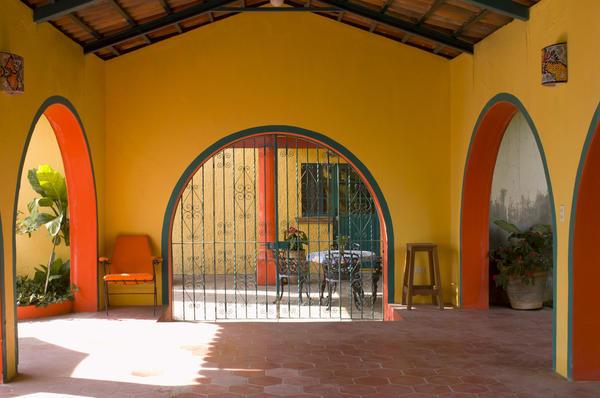
Simply put — weathering. When choosing exterior paint, you must also take into account this fact plus to those described above to select interior paint.
Exterior paint shall be:
That's all I wanted to tell you about the choice of colors.
The subtleties of tintingNow about tinting. Color matching is one of the most enjoyable moments for all repairs. You will have hours of walk around the house, putting the walls of the small squares, choosing the shades and tones. And then the producers tried... In any store you will find a plethora of bottles with the colors that can be mixed together, getting new shades, and offer tinting. In some cases it is absolutely free (if you select a certain type of paint), well, you will be asked to pay only the pigments for tinting. How to choose the color and for what room I paint will not. I will tell you how it is done, you will get up and give General recommendations.
If you decide to tinted paint yourself, then you will have to use the pigments or tinting pastes.
Their huge number of types: concentrated and not very versatile and only for emulsion paints, powder and paste, and other, and miscellaneous. Usually on the packaging or booklet of the production is raskolotka, that is, you show what color you will get. Independently calculating the proportions, add necessary amount of pigment in the paint, stir and get the desired intensity and saturation of color. If you add multiple pigments to obtain the complementary color, however, such experiments are best done people with experience or to experiment on small amounts of paint.
The advantages of this type of tinting:
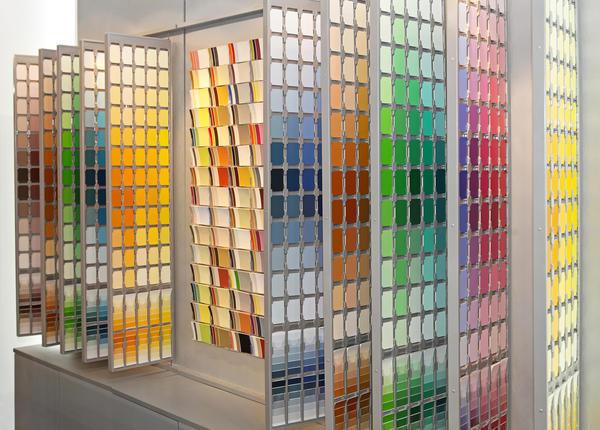
As mentioned above, provide this service in large stores of building materials or their network. Tinting machines are of two types: manual and automatic. Not going to paint the peculiarities of each, because, as a rule, you will have to settle for the one that is there) In the tinting machine is 16 flasks with pigments of various colors. Pigments these sverhkontsentratsiya, so other times for tinting of paint will cover a couple of drops. A computer program calculates how many and what pigment must be added to koleruemogo amount for obtaining the desired color. As a rule, tinting machine equipped with a mixer or a device for mixing paint.
When you ask for this service, you will be offered rasklinivanie fan for color selection.
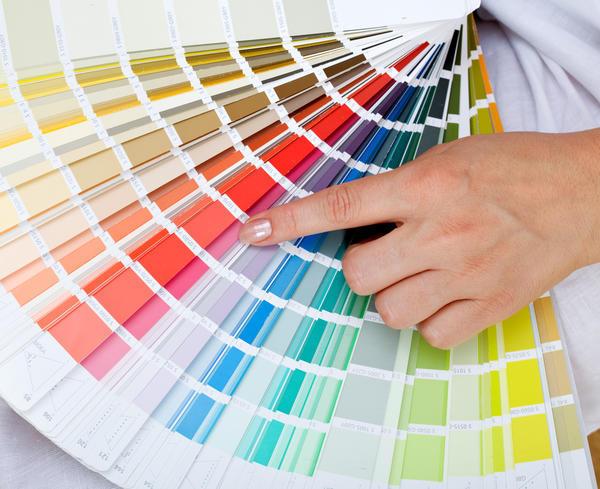
The fan will offer a basic color and its gradation from dark to light. The cost usually depends on the number of pigments used in the tinting in the selected color. Some stores put a fixed price per liter (or kilogram) of colored paint. However, this approach only stores.
The fact that all of the pigments vary in price, so as to obtain the specific colors used are totally different components. From my experience I know that the difference in cost of tinting sometimes reaches a thousand and more roubles. So when you store to the question: "how much is tinting?" — answer: "I don't know, depends on the color," it's not an attempt of deception, but rather an indication of honesty of the seller, and should you order tinting. If choosing the color, you will hear unpleasant a large amount, then try to "break" other colors similar to this one. Sometimes a computer program for tinting almost the same color involves the use of different pigments. And as the price of the pigments are different, the same color can cost quite acceptable.
Dark and vibrant colorsOnly by using this type of tinting you can get dark and saturated colors. On resolutionon fan they are usually extreme in the first and in the second row. However, to do this you have to take the base paint. This is the same paint, but not white. It comes from the factory already tinted in a certain color, or comes in transparent and translucent form. The cost base may be different from the price for conventional white paint, and in large and smaller side. It depends on the manufacturer. To get vivid colors of the pigment in a transparent base out more, and therefore tinting, consequently, more expensive. And here, perhaps, more profitable color paint in the shop with a fixed price per liter or kilogram.
Thus, the advantages of this type of tinting:
As any finishing material, paint peculiar defects. Moreover, the cause of a disease is often not the quality of the paint, and the errors when applying the coating to the surface. So remember a minimum of simple rules:
P. S. And remember, only by changing their consumption — together we change the world! © Join us at Facebook , Vkontakte, Odnoklassniki
Source: www.7dach.ru/LilyBarta/vse-o-vybore-kraski-dlya-sten-37959.html

A bit of history paintsProbably none of us have ever thought about the question: how old are the inks? Meanwhile, archaeologists claim that people are already 17 thousand years, just imagine! Yes, of course, before the paint was a slightly different composition, but it has evolved along with humanity. The very nature of paints for centuries has not changed, was added different binding elements, and methods change the color. Because people saw the world in color and that I wanted to paint it. To obtain the pigments used and the minerals, and herbs — all that gives earth, including herself.
And later invented chemical compositions and obtained the desired shade. In the middle ages the pigments included even dangerous lead and arsenic... people's Lives these colors, of course, shortened, but perhaps thanks to them that we still admire paintings and frescoes of those times. In our 21st century paint tested for environmental friendliness, toxicity, safety... and in the diversity of colors and their application in our day you can write a thesis! However, we have another problem, why limit ourselves to a compact story.
The composition of water-dispersion paintsFirst, let's be clear about the scientific parameters of the composition of the aqueous paint. I will try to explain everything simple and clear. Water-dispersion paint is, in fact, water-filling. Filling, as a rule, represent a binder based on synthetic latexes and copolymers (acrylic or vinyl acetate). If to tell even easier is particles in the water which, after application to a surface (painting) and evaporation of the water, moving closer. Then these particles adhere to each other and form a film. Here and all science))

Water-dispersion paint contains no solvents. And even in our age, in it there are synthetic materials, it's still environmentally friendly, safe, easy to manufacture and use. In addition, water-based paint is odorless and "friendly" with almost any types of surfaces (excellent traction, adhesion). Therefore, it is widely used in construction industry for production facilities and in home repairs.
All water-based paints initially can be divided into two groups:
- Interior, that is designed to cover the walls inside.
- Facade - the exterior.
More attention I will give the acrylic paint, because, thanks to their qualities, they are more than others suitable for home use. This is a fairly common product that you will always find on the shelves of any hardware store. Acrylic paint is a water-dispersion acrylic paint binder (acrylates, or their copolymers). It is economical and easy to use, dries quickly, forms on the surface of the coating is vapor permeable ("breathes"). An important caveat: acrylic paints retain their color well and don't fade, withstanding intense UV radiation.
Since the surface treatment you have chosen painting, such a decision is hard to call wrong. Indeed, what could be the cons in this choice? On the contrary all the way)
- Painting is the most inexpensive kind of treatment. Difficult to find something more economical for the walls. The price for this type of coverage can vary only depending on manufacturer (brand), and some other nuances, which we will discuss below.
- The job requires special skills. It is enough to follow simple rules to self to paint any surface in the house. With some types of colouring even a child will cope! And generally agree that many such even pleasure) Because the desire to create inherent in each, but the gift of the artist, alas, is not given to everyone. So: for those who, as they say, "neither sing nor draw" (like me))), boldly stated — the painting of walls, ceilings and other things you can handle without problems!))
- Another advantage is the possibility to choose the desired color. You will never have problems with that in the table no tinting of the shade you want. Moreover, for a long time, I've noticed that the customers difficulties arise because of the abundance of these flowers. Sometimes we had to wait for weeks while going to choose one shade from several any.
- In fact, there are more environmentally friendly and safe type of coating than painting with acrylic paints. And, if you are concerned about a health issue, it was reported that the level of sustainability they are next to natural materials. You can challenge this statement by listing other types of finishes: wood, stone, Wallpaper made of natural fibers. But do not forget that the Wallpaper stick to the glue, which is far from natural, as the composition of mastics for stone. And the wood will be protected from fungi and insects by using chemicals, antiseptic.
- The paintwork over time, it is very easy to update. This means if there is a contamination of that well, does not wash (familiar situation for those who have children)), it is enough for a small amount of paint of the same color to hide the defect. If you need to update the cover (cosmetic repair), just go with one coat of paint of the same color that was, but the Wallpaper would have to change.
- Another plus I should mention the durability of the coating against mechanical and chemical attack. Choosing the right type of paint you will be able to exploit it for years! If you want to argue with this statement, then, at the time, chose the wrong paint) Below we will return to this issue, but just note that the color durable.
The main disadvantage of painting is the surface preparation before its application. Ie: walls should be smooth plastered and desirable — perfect. To achieve this ideal, frankly, quite difficult, especially in older homes. You have to align the wall, edit the angles and stuff. However, to be honest, any other kind of decoration also can not hide the strong irregularities.
Now try to refute other cons that I most frequently heard from clients:
— I would have painted, but I have a new house — there is a shrinkage of the walls and plaster covered with cracks and it will be noticeable.
Indeed, when painting you need to consider some factors and this is one of them. However, this situation also there is a way — you can use fiberglass (fibreglass Wallpaper for painting). Only they are able to really reinforce a new surface, because sometimes the cracks are very macro! And any other Wallpaper can not necessarily macrofactors and tear. And selecting the glass cloth, you protect yourself from such troubles and you'll be able to repaint them to a few times. And, again, this option is not more expensive than other types of finishes — stone, tile or panels.
I don't like the smooth surface, I love texture.
These arguments against painting, too, put forward often enough. However, and here the producers have long provided for all of your "want" and "would be nice", and if a responsible approach to the selection and product search, you will find a lot of options!
- The texture of the paint. This is the same acrylic substance with the addition of different texture components. It could be sawdust, rubber crumb of different caliber, and the calcinated granules and any other material. The use of this type of paint will help you achieve uneven or rough surface of the wall, and, optionally, the use of different types of application, even create your own custom design.
- Fiberglass. In addition to absolutely smooth (this is called gossamer), manufacturers have lots of options from textured, ranging from simple matting to tapestry and others. They are so durable that they are almost impossible to damage, so they are not afraid of animals and children (where do without them)). Glass cloth Wallpaper will withstand repeated coloring. The only problem you have when you want to get rid of them — they are difficult to come off from the walls.
- Don't want forever? Then you textured paintable Wallpaper: vinyl on non-woven basis, and there are paper. And they are not as durable as fiberglass, but both will give your walls a superb relief (by the way, images the Wallpaper — an incredible number). After painting on the wall will not be visible joints, and repaint the Wallpaper is allowed up to 4 times. To be honest, it can be more, but then the relief surface almost disappear under layers of paint.

- Why many are rushing to abandon the painting? Because of surface gloss. As a rule, water-based paints have a matte degree, that is, not shiny. However, one cannot deny the fact that the matte surface traces of contamination visible stronger than glossy, especially traces from the touch. Quite often you can hear complaints that for matte surfaces the fingerprints are so clear, that it is possible to study fingerprinting. In the result space, where are the knobs and switches, look bad (sloppy, dirty), and a variety of pads spoil the overall look of the interior. Taking into account this lack of matte paint and to meet the desires of consumers, many manufacturers began to produce a glossy water-based paints. And some went even further: if you look, you will find on the market these goods and semi-Matt and silk-gloss, and even matte silky! We conclude — gloss coating can also be selected.
- And, perhaps, the last point I voiced another category of customers: "Paint? But it's so boring, mundane," they say. And again, I believe that this statement is completely uncalled for! Do not "chase" the interior in paint, try the paint to "drive" in the interior. You can "play" with color, texture, volume; create anything you want — any style, to translate into reality the most daring ideas. And paint is easier to do than any other material.
The importance of quality paintlet us start with a quality paint, which you can feel free to ask sellers. The paint should be:
- White. All paints differ in the quantitative content of white pigment. Those where it is high enough to have exceptional white and not change color (not yellow) for 5-6 years. It was with this white paint when tinting, you will get a clean and beautiful color. If the paint is not initially white, then, after adding the pigment, it will dim, unattractive, dirty hue. Therefore, the whiter the paint the better. Often the manufacturer specifies the degree of whiteness, sometimes simple puts the mark "super".
- Permanent. This feature gives the ability to withstand sunlight, keeping its color. This feature of the material depends on the pigments included in the ink composition, and a binder. It is logical to assume that this characteristic is important, especially for exterior paints. However, the Windows are not protecting from ultraviolet radiation, and in Sunny weather, your walls will simply burn, so lightfastness is important for interior paints. Definitely try to learn about this factor. As a rule, the manufacturer does not hide the presence of UF-filters, or writes that its products are permanent. If it isn't there, then it is worth considering.
- Opaque. Not a very literary word, but in the lexicon of paint producers is a very important indicator. It determines the amount of paint required to cover all defects in the painted surface. Rarely manufacturers specify this figure as it should be — in grams dry matter per square meter, that is, how much paint remains on the wall after the evaporation of water. Residue dry matter for acrylic paint should be 40% and above. Often on labels you can see the class of opacity indicated by the numbers or degrees. Know this: the higher the grade or the degree, the better. That is, class 1 will allow you to use one layer to paint over a darker bottom layer, and that will Shine through. Sometimes coverage is indicated in the form of the final number of layers. It should not be more than two, and if the manufacturer writes on the label: "Add the required number of layers", or cryptically indicates: "two layers", it is a clear sign of poor opacity colors.
- To be thixotropic. The figure I note the latter because he may not be as important as the previous one. Thixotropy — the ability of paint to restore the original structure. If you had early to paint something, then you have probably noticed that at rest the paint more thick, but by mechanical action (shaking, stirring) the plasticity of the paint increases. So: thixotropic paint after applying again thickens, thereby enabling to avoid such defects as stains or traces of tassels. This is especially important when paint a vertical surface.
More often, consumers are concerned about consumption of paint, and he believes that this indicator is important. However, in practice I have not noticed a significant difference in the data from different manufacturers. It is worth considering that, depending on the type of base paint consumption either decreases or on the contrary, increases. If the wall is prepared and primed, or updated a previously painted surface, the paint consumption will be minimal. And here is the Wallpaper for painting (especially fiberglass) "eat" the paint a lot more and the flow will be maximum. The manufacturer usually gives the average paint consumption: 1 litre to 6-8 sq metres. Given your size and the type of surface is not difficult to calculate the approximate volume of necessary products.
In the beginning of the article I said that the paint is durable. This property depends on the fastness to stress. Any manufacturer usually interior paint is available in 3 types:
For walls and ceilings is unstable covering for areas with a low level of traffic, suffers only dry cleaning, whitewashing allows the chalk, if it is rubbed with a hand, is unstable to mechanical stress. Moisture-proof coatings for space with a small level of traffic, tolerate wet cleaning (wiping and no more), is unstable to mechanical stress. Washable is a resistant coating for areas with heavy traffic of people, tolerate wet cleaning, soak a wash with a detergent composition, several cycles of washing with a brush. Note that this gradation is not common, so the paint name may be different, but in General, it is still presented in these 3 types. Some manufacturers add their views, giving it some special quality. For example, "svirbely ceiling" or "supermouse for the walls." But, anyway, she belongs to one of the above three types. Sometimes produce several classes or different series of products, but in each such series, as a rule, there are 3 types according to the degree of resistance. The manufacturer does not seek to confuse you, rather, it tries to cater to all consumer segments, supplying the market with expensive products, and the commodity economy, and the paint is of poor quality. Alas, it is, and, unfortunately, she also finds his client. The lower the class the lower the price.
When buying paint you should simply first choose a brand, then its products (if any), and then one of the three types of degrees of resistance. As a rule, the cost of paint types is also different: washable paint is more expensive moisture-proof, moisture-proof and more expensive than that for ceilings.
For some more resistant coating in the home are choosing exterior paint, but I don't recommend to do it. Exterior paint is endowed with some of the other factors, it contains additives that are undesirable for the indoor environment, and the cost will be higher than the interior. For the house, where warm and dry, well suited to the above types: unstable for ceilings, moisture resistant for the walls in the halls and bedrooms, washable at children's, hallways, kitchen. However, there are times when exterior paint is appropriate in the premises: it is weatherproof, therefore suitable for unheated outbuildings: vestibule, cellar, boiler room, veranda, and others.
FacadeLet's talk about the exterior paint. The main criterion when choosing a material for outdoor use is its ability to resist temperature changes and, as a consequence, humidity.

Simply put — weathering. When choosing exterior paint, you must also take into account this fact plus to those described above to select interior paint.
Exterior paint shall be:
- White to get the desired shade.
- Opaque to block out the darker background.
- Permanent, not to fade or lose color.
- Thixotropic to avoid stains and traces after application.
- Atmosferostojkosti to withstand extremes of temperature, precipitation, humidity.
That's all I wanted to tell you about the choice of colors.
The subtleties of tintingNow about tinting. Color matching is one of the most enjoyable moments for all repairs. You will have hours of walk around the house, putting the walls of the small squares, choosing the shades and tones. And then the producers tried... In any store you will find a plethora of bottles with the colors that can be mixed together, getting new shades, and offer tinting. In some cases it is absolutely free (if you select a certain type of paint), well, you will be asked to pay only the pigments for tinting. How to choose the color and for what room I paint will not. I will tell you how it is done, you will get up and give General recommendations.
If you decide to tinted paint yourself, then you will have to use the pigments or tinting pastes.
Their huge number of types: concentrated and not very versatile and only for emulsion paints, powder and paste, and other, and miscellaneous. Usually on the packaging or booklet of the production is raskolotka, that is, you show what color you will get. Independently calculating the proportions, add necessary amount of pigment in the paint, stir and get the desired intensity and saturation of color. If you add multiple pigments to obtain the complementary color, however, such experiments are best done people with experience or to experiment on small amounts of paint.
The advantages of this type of tinting:
- Wide range of colors, the ability to get any color but dark and saturated.
- Cheap. Some manufacturers offer pigments cost up to 50 rubles.
- You have to calculate the exact amount of pigment and is difficult to color the same color again. The more difficult it will be to do it through any time if you need a minor repair.
- Requires physical effort to prepare, but for large volumes — accessories: nozzles, mixers, tanks.
- No way to get bright, saturated and dark colors. That is, you only get pastel colors. And, though the perception of brightness and color saturation are individually, I think you understood me correctly.
- If you have multiple cans of paint for tinting with one color, it is desirable to merge them and tinted in a single container.
- When the tinting of facade paints use pigments that are suitable for outdoor use.
- Zahlreiche first the paint is a tone or two lighter than the one that liked raskalennoi the table and make a "wykres" on the wall. Typography rarely reflects the color correctly, do not forget that on the wall in greater amount of color will appear brighter and richer than on a small square in the table. Wait until the "wykres" completely dry: some paint after drying darker, and others lighter. Only after the evaluation is ready "wykres" on the wall you will understand whether you need paint for a darker tone or two.

As mentioned above, provide this service in large stores of building materials or their network. Tinting machines are of two types: manual and automatic. Not going to paint the peculiarities of each, because, as a rule, you will have to settle for the one that is there) In the tinting machine is 16 flasks with pigments of various colors. Pigments these sverhkontsentratsiya, so other times for tinting of paint will cover a couple of drops. A computer program calculates how many and what pigment must be added to koleruemogo amount for obtaining the desired color. As a rule, tinting machine equipped with a mixer or a device for mixing paint.
When you ask for this service, you will be offered rasklinivanie fan for color selection.

The fan will offer a basic color and its gradation from dark to light. The cost usually depends on the number of pigments used in the tinting in the selected color. Some stores put a fixed price per liter (or kilogram) of colored paint. However, this approach only stores.
The fact that all of the pigments vary in price, so as to obtain the specific colors used are totally different components. From my experience I know that the difference in cost of tinting sometimes reaches a thousand and more roubles. So when you store to the question: "how much is tinting?" — answer: "I don't know, depends on the color," it's not an attempt of deception, but rather an indication of honesty of the seller, and should you order tinting. If choosing the color, you will hear unpleasant a large amount, then try to "break" other colors similar to this one. Sometimes a computer program for tinting almost the same color involves the use of different pigments. And as the price of the pigments are different, the same color can cost quite acceptable.
Dark and vibrant colorsOnly by using this type of tinting you can get dark and saturated colors. On resolutionon fan they are usually extreme in the first and in the second row. However, to do this you have to take the base paint. This is the same paint, but not white. It comes from the factory already tinted in a certain color, or comes in transparent and translucent form. The cost base may be different from the price for conventional white paint, and in large and smaller side. It depends on the manufacturer. To get vivid colors of the pigment in a transparent base out more, and therefore tinting, consequently, more expensive. And here, perhaps, more profitable color paint in the shop with a fixed price per liter or kilogram.
Thus, the advantages of this type of tinting:
- A huge selection of colors, including bright and vibrant colors.
- You don't have to spend time and energy on tinting, and mixing.
- The ability to easily recreate the tinted color even after a long time. It is sufficient to record the name, type or code of the tinting table.
- The cost of tinting some colors is quite large.
- For tinting some bright colors will have to buy the base paint.
- Perhaps the limitation in the choice of type of paint. This is because tinting machine supplied by a particular manufacturer of the paint. From him do the tinting program and pigments, which are tested on the paint. That is, the manufacturer guarantees the exact matching of the tinting with tinting table using only its products, which may not suit you or price. Many sellers go towards the buyer and tintable any kind of paint that you have to buy, but with the caveat that they do not guarantee 100% matches. However, from my experience, I will note for you that the difference in color will not be significant and noticeable. Maybe a little darker or lighter, and no more.
- You will have to buy a tinting paint in the center. Most likely, the seller will not agree to tinted paint, which you buy doesn't have it. Tinting machine manufacturers — this is not the way of earnings, and an auxiliary tool for the sale of its paint. Therefore, a good stores never take money for the service of tinting only the cost of the pigments. That is, they sell their own paint and they will not be tinted something purchased elsewhere.
As any finishing material, paint peculiar defects. Moreover, the cause of a disease is often not the quality of the paint, and the errors when applying the coating to the surface. So remember a minimum of simple rules:
- Choose the right type of paint. About the durability of the paint saying its performance properties.
- The paint is applied on absolutely dry surface. Otherwise, there will appear bubbles.
- The paint can be applied on the plaster, but it should be done at least a month after the completion of plastering work, as for the hardening of the plaster necessary carbon dioxide. If you paint before, will admire the rusty stains on the wall.
- Do not forget to use a special primer before painting, especially if you have new or unstable surface and "bulk" basis. Swipe a wet hand on the wall: if there are grains of sand, go to the store for a primer of deep penetration. Otherwise, after drying, the paint will fall off together with the base.
- Do not dilute the paint with water in a percentage greater than that specified in the instructions. This can change the chemical composition and break properties.
- Do not mix paints of different types, it changes the structure and breaks properties.
- Before painting, always conduct a series of preventive measures for the repair of drainage system, waterproofing and other things. Do not allow significant moisture into the walls. Otherwise, you will look like the walls are growing mold and mushrooms.
- Do not allow the freezing of latex paint after purchase. Its weather-resistant and other qualities of the paint will only find on the walls after drying. Banks products are not stand low temperatures, their transporterowych in cars with heated body. So, if you buy the paint in the winter, then put into the cabin and, as quickly as possible, bring into the house to heat. After freezing the latex paint is considered to be unsuitable, loses its properties and appearance.
- Choose a reliable paint manufacturer. The requirements for it are simple and clear — it's high reputation and stable quality of products. Internet and reviews from other users to help you))
P. S. And remember, only by changing their consumption — together we change the world! © Join us at Facebook , Vkontakte, Odnoklassniki
Source: www.7dach.ru/LilyBarta/vse-o-vybore-kraski-dlya-sten-37959.html


